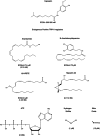The role of endogenous molecules in modulating pain through transient receptor potential vanilloid 1 (TRPV1)
- PMID: 23613529
- PMCID: PMC3717213
- DOI: 10.1113/jphysiol.2013.251751
The role of endogenous molecules in modulating pain through transient receptor potential vanilloid 1 (TRPV1)
Abstract
Pain is a physiological response to a noxious stimulus that decreases the quality of life of those sufferring from it. Research aimed at finding new therapeutic targets for the treatment of several maladies, including pain, has led to the discovery of numerous molecular regulators of ion channels in primary afferent nociceptive neurons. Among these receptors is TRPV1 (transient receptor potential vanilloid 1), a member of the TRP family of ion channels. TRPV1 is a calcium-permeable channel, which is activated or modulated by diverse exogenous noxious stimuli such as high temperatures, changes in pH, and irritant and pungent compounds, and by selected molecules released during tissue damage and inflammatory processes. During the last decade the number of endogenous regulators of TRPV1's activity has increased to include lipids that can negatively regulate TRPV1, as is the case for cholesterol and PIP2 (phosphatidylinositol 4,5-biphosphate) while, in contrast, other lipids produced in response to tissue injury and ischaemic processes are known to positively regulate TRPV1. Among the latter, lysophosphatidic acid activates TRPV1 while amines such as N-acyl-ethanolamines and N-acyl-dopamines can sensitize or directly activate TRPV1. It has also been found that nucleotides such as ATP act as mediators of chemically induced nociception and pain and gases, such as hydrogen sulphide and nitric oxide, lead to TRPV1 activation. Finally, the products of lipoxygenases and omega-3 fatty acids among other molecules, such as divalent cations, have also been shown to endogenously regulate TRPV1 activity. Here we provide a comprehensive review of endogenous small molecules that regulate the function of TRPV1. Acting through mechanisms that lead to sensitization and desensitization of TRPV1, these molecules regulate pathways involved in pain and nociception. Understanding how these compounds modify TRPV1 activity will allow us to comprehend how some pathologies are associated with its deregulation.
Figures





Similar articles
-
Capsaicin receptor: TRPV1 a promiscuous TRP channel.Handb Exp Pharmacol. 2007;(179):155-71. doi: 10.1007/978-3-540-34891-7_9. Handb Exp Pharmacol. 2007. PMID: 17217056 Review.
-
Extracellular cations sensitize and gate capsaicin receptor TRPV1 modulating pain signaling.J Neurosci. 2005 May 25;25(21):5109-16. doi: 10.1523/JNEUROSCI.0237-05.2005. J Neurosci. 2005. PMID: 15917451 Free PMC article.
-
Presynaptic inhibition of transient receptor potential vanilloid type 1 (TRPV1) receptors by noradrenaline in nociceptive neurons.J Physiol. 2017 Apr 15;595(8):2639-2660. doi: 10.1113/JP273455. Epub 2017 Feb 22. J Physiol. 2017. PMID: 28094445 Free PMC article.
-
TRPV1 receptors in sensitisation of cough and pain reflexes.Pulm Pharmacol Ther. 2009 Apr;22(2):65-70. doi: 10.1016/j.pupt.2008.12.014. Epub 2008 Dec 27. Pulm Pharmacol Ther. 2009. PMID: 19141328 Review.
-
A painful link between the TRPV1 channel and lysophosphatidic acid.Life Sci. 2015 Mar 15;125:15-24. doi: 10.1016/j.lfs.2014.10.004. Epub 2014 Oct 14. Life Sci. 2015. PMID: 25445434 Review.
Cited by
-
Polymodal roles of transient receptor potential channels in the control of ocular function.Eye Vis (Lond). 2015 Mar 2;2:5. doi: 10.1186/s40662-015-0016-4. eCollection 2015. Eye Vis (Lond). 2015. PMID: 26605361 Free PMC article. Review.
-
TRPV1 channels and the progesterone receptor Sig-1R interact to regulate pain.Proc Natl Acad Sci U S A. 2018 Feb 13;115(7):E1657-E1666. doi: 10.1073/pnas.1715972115. Epub 2018 Jan 29. Proc Natl Acad Sci U S A. 2018. PMID: 29378958 Free PMC article.
-
Interaction Between the Cannabinoid and Vanilloid Systems on Anxiety in Male Rats.Basic Clin Neurosci. 2017 Mar-Apr;8(2):129-137. doi: 10.18869/nirp.bcn.8.2.129. Basic Clin Neurosci. 2017. PMID: 28539997 Free PMC article.
-
eIF2α phosphorylation controls thermal nociception.Proc Natl Acad Sci U S A. 2016 Oct 18;113(42):11949-11954. doi: 10.1073/pnas.1614047113. Epub 2016 Oct 3. Proc Natl Acad Sci U S A. 2016. PMID: 27698114 Free PMC article.
-
Regulation of ThermoTRP Channels by PIP2 and Cholesterol.Adv Exp Med Biol. 2023;1422:245-277. doi: 10.1007/978-3-031-21547-6_9. Adv Exp Med Biol. 2023. PMID: 36988884
References
-
- Almasi R, Szoke E, Bolcskei K, Varga A, Riedl Z, Sandor Z, Szolcsanyi J, Petho G. Actions of 3-methyl-N-oleoyldopamine, 4-methyl-N-oleoyldopamine and N-oleoylethanolamide on the rat TRPV1 receptor in vitro and in vivo. Life Sci. 2008;82:644–651. - PubMed
-
- Alsalem M, Wong A, Millns P, Arya PH, Chan MS, Bennett A, Barrett DA, Chapman V, Kendall DA. The contribution of the endogenous TRPV1 ligands 9-HODE and 13-HODE to nociceptive processing and their role in peripheral inflammatory pain mechanisms. British journal of pharmacology. 2013;168:1961–1974. - PMC - PubMed
-
- Baez-Nieto D, Castillo JP, Dragicevic C, Alvarez O, Latorre R. Thermo-TRP channels: biophysics of polymodal receptors. Adv Exp Med Biol. 2011;704:469–490. - PubMed
Publication types
MeSH terms
Substances
LinkOut - more resources
Full Text Sources
Other Literature Sources
Medical

